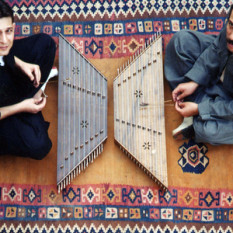The santur (also santūr, santour, santoor) (Persian: سنتور) is a hammered dulcimer, of Persian origin. It is a trapezoid-shaped box often made of walnut or different exotic woods. The original classical santur has 72 strings. The name can be roughly described as one hundred strings in Persian. The oval-shaped mallets (Mezrabs) are feather-weight and are held between the index and middle fingers.
A typical santur has two sets of bridges, providing a range of approximately three octaves. The right-hand strings are made of a combined mixture of copper and brass, while the left-hand strings are made of stainless steel. Two rows of 9 articles called "Kharak" (18 kharaks) divide the santur into three positions. Each lead four unitone strings to the right and left side of the instrument. Each note repeats three times in three positions [making (9*3) 27 tones all together and doubles in frequency going to the left. As four notes are repeated in tonation there are 23 tones in Santur. The santur is primarily tuned to a variety of different diatonic scales which utilize 1/4 tones (semi-tones). There are 12 modes of Persian classical music, known as the "Radif" which consists of 12 Dastgahs or Modes. Each Dastgah has its own tuning and character which derives from the different parts of Iran (Persia) which dates back thousands of years and was only preserved through performance until the late Ostad Abol Hassan Saba the legendary Master of Persian classical music, notated and categorized 3500 years of Persian music into the "Radif of Saba." .

